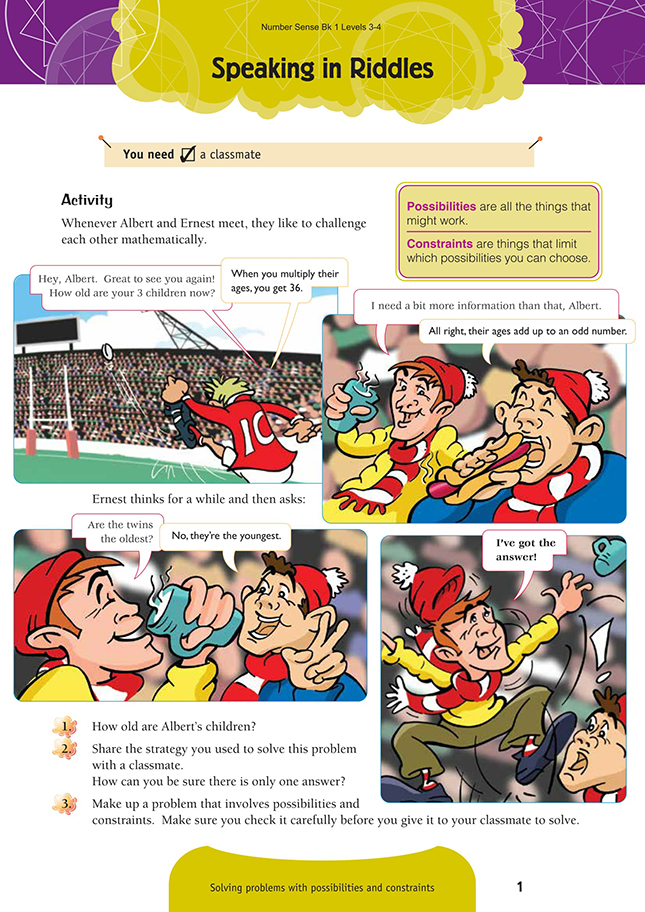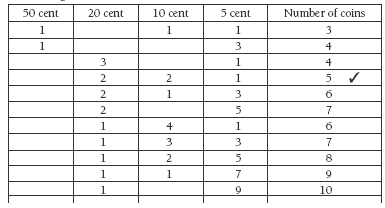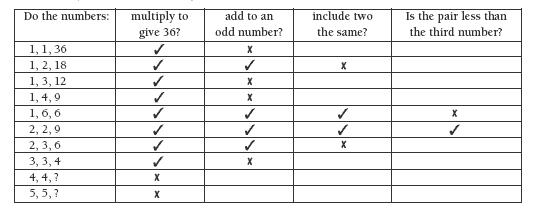This is a level 4 number activity from the Figure It Out series. It relates to Stage 7 of the Number Framework.
A PDF of the student activity is included.
Click on the image to enlarge it. Click again to close. Download PDF (322 KB)
use basic facts and mental strategies to solve problems
Number Framework Links
Use this activity to encourage transition from advanced additive strategies (stage 6) to advanced multiplicative strategies (stage 7).
FIO, Levels 3-4, Number Sense and Algebraic Thinking, Book One, Speaking Riddles, page 1
A classmate
This activity involves solving problems with possibilities and constraints. It’s a useful activity for students with a good recall of basic multiplication and division facts who are learning to express whole numbers as the product of prime numbers. These students will need to be at the advanced additive stage at least for multiplication and division because the problem involves finding factors of 36.
This problem is a simplified version of a problem created by George Polya, a renowned mathematician, who was often called “the father of problem solving”. It contains several clues about the ages of Albert’s children that do not appear to be sufficient to answer the problem. But they are!
The important information the students need to identify is:
• The problem is asking them to find out each child’s age.
• There are 3 children.
• The product of the 3 ages is 36.
• The sum of the ages is an odd number.
• 2 children are the same age (twins).
• The twins are the youngest.
The first clue is that the three children’s ages multiply together to give a product of 36. Encourage the students to be systematic in finding all the possibilities for the ages. One way is to begin with 1 as a factor and list the possibilities: 1 x 1 x 36 (36 is rather old for a child), 1 x 2 x 18 (also an old child, but possible), 1 x 3 x 12, 1 x 4 x 9, and 1 x 6 x 6. (From the later clue about twins, which includes the fact that they are the youngest, we know that none of these are possibilities for the ages.) Note that once all the possibilities using a particular factor are exhausted, this narrows down
the possibilities because that factor cannot be used again.
The students could then work on the possibilities with 2 as a factor, then 3 as a factor, and so on. This systematic search might lead to the following possibilities: 2 x 2 x 9, 2 x 3 x 6, and 3 x 3 x 4. Given the twins clue, only 2 x 2 x 9 and 3 x 3 x 4 might work, although the students may already have eliminated 3 x 3 x 4 because of the odd number clue. (3 + 3 + 4 adds up to 10, which is an even number. 2 + 2 + 9 adds up to 13.) So this leaves only 2 x 2 x 9.
Question 3 involves the idea of possibilities and constraints. In such problems, an idea creates a number of possibilities that are then restricted by some stipulation (constraint). When the students come to do question 3, they may find it very difficult to know where to start and to know when they have finished. You could first go through the process with them, creating a whole-class problem. This will give your students the necessary scaffolding. It would also help them if you limit problems to those that involve just 3 (different) ages. Here is one example:
• Choose three “ages”: 5, 11, 13
• Make a constraint (condition): The oldest person is 8 years older than the youngest person.
• Make a second constraint: All the ages are odd.
• Make a third constraint: The sum of the ages is 29.
Check that the problem is solvable (that is, 3 numbers can be found that meet all 3 constraints, and there is only 1 such set of numbers). This can be done using a table:
Note that the missing third number means that pairs can only be eliminated or queried in the “constraint 2” column because it is not known if the third number is even or odd at this point. Next, get the students to brainstorm different constraints that might be used for this same single set of numbers. There are many possibilities, including:
• The middle age is more than twice the youngest age.
• Each age is less than 15.
• The older two ages are only 2 years apart.
• The youngest and oldest ages add up to 18.
• All three ages are prime numbers.
• The two older ages add up to 24.
• The age of the oldest person is 3 less than the sum of the ages of the other two.
The students may wonder if 3 constraints are always enough for a 3-age problem to be solved. Depending on your group, you may like to let them explore this hypothesis themselves. In fact, 3 constraints should always be enough (as long as they contribute genuinely new information). Likewise, 2 constraints should be enough for a 2-age problem and 4 constraints enough for a 4-age problem.
Another example you could work through with the group is based on money. For example, “Melanie has 65 cents in her hand, made up of coins” opens up many possibilities, including six 10 cent coins and one 5 cent coin; one 50 cent, one 10 cent, and one 5 cent coin; thirteen 5 cent coins; and so on. Adding the constraint “the amount is made up of five coins” results in all but one of the possibilities being eliminated: two 20 cent coins, two 10 cent coins, and one 5 cent coin. The students may need help with organising possibilities. Again, a table or a systematic list is a good way to ensure that all of the possibilities are accounted for. For example, a partial table for Melanie’s problem (above) might look like this:
Once they have the idea, let your students create their own problems involving possibilities and constraints for each other to solve. This will provide them with an opportunity to think logically and systematically. If they are using 3 ages, suggest that they keep the ages fairly close to each other, at least until they are sure that they know what they are doing. This will limit the number of possibilities to be tested. You could suggest other suitable contexts, such as a group of animals with 2 legs and 4 legs in a pen or posting a letter costing $1 with possible stamps of 10 cents, 30
cents, 50 cents, and so on.
Answers to Activity
1. 2, 2, and 9
2. Strategies may vary, but you need to systematically list the possibilities and constraints in the problem to find the answer that works. To make sure there are no other possible answers, you need to try all the sets of 3 factors that multiply to 36. (For example, 3, 3, and 4 multiply to 36, but they do not add to an odd number.) You could use a table, such as:
(Note that you eliminate a group of 3 numbers as soon as a applies.)
3. Problems will vary.



